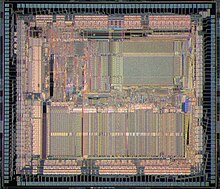R3000
| Designer | MIPS Computer Systems |
|---|---|
| Bits | 32-bit |
| Design | RISC |
The R3000 is a full 32 bit RISC microprocessor chipset developed by MIPS Computer Systems that implemented the MIPS I instruction set architecture (ISA). Introduced in June 1988, it was the second MIPS implementation, succeeding the R2000 as the flagship MIPS microprocessor. It operated at 20, 25 and 33.33 MHz.
The MIPS 1 instruction set is very small compared to the instruction sets of other microprocessors, such as the contemporary 80x86 and 680x0 architectures, as it includes only most commonly used instructions and supports very limited number of addressing modes. The small number of CPU instructions, as well as other instruction set features—fixed instruction length and only three different types of instruction formats—greatly simplify instruction decoding and processing. To speed up processing even further the CPU employs a 5-stage instruction pipeline. The pipeline design allows the R3000 CPU to execute most instructions at a rate close to 1 instruction per cycle.
The MIPS architecture supports up to four coprocessors. In addition to the CPU core, the R3000 microprocessor includes a Control Processor (CP), which contains a Translation Lookaside Buffer and a Memory Management Unit.[1] The CP works as a coprocessor. Besides the CP, the R3000 can also support an external R3010 numeric coprocessor and two other external coprocessors.
The R3000 CPU does not include its own level 1 cache. Instead, the processor has an on-chip cache controller which controls separate external data and instruction caches. The size of each external cache can be as large as 256 KB. The CPU can access both caches during the same CPU cycle.
The R3000 found much success and was used by many companies in their workstations and servers. Users included:
- Ardent Computer
Digital Equipment Corporation (DEC) for their DECstation workstations and multiprocessor DECsystem servers
Evans & Sutherland for their Vision (ESV) series workstations
MIPS Computer Systems for their MIPS RISC/os Unix workstations and servers.
NEC for their RISC EWS4800 workstations and UP4800 servers.- Prime Computer
- Pyramid Technology
- Seiko Epson
Silicon Graphics for their Professional IRIS, Personal IRIS and Indigo workstations, and the multiprocessor Power Series visualization systems
Sony for their PlayStation and PlayStation 2 (clocked at 37.5 MHz for use as an I/O CPU and at 33.8 MHz for compatibility with PlayStation games) video game consoles, and NEWS workstations, as well as the Bemani System 573 Analog arcade unit, which runs on the R3000A.
Tandem Computers for their NonStop Cyclone/R and CLX/R fault-tolerant servers
Whitechapel Workstations for their Hitech-20 workstation
New Horizons Probe [2][3][4]
The R3000 was also used as a high-end embedded microprocessor, and when advances in technology rendered it obsolete for high-performance systems, it was used as a low-cost embedded design. Companies such as LSI Logic developed derivatives of the R3000 specifically for embedded systems.
The R3000 was a further development of the R2000 with minor improvements including larger translation lookaside buffer and faster bus to the external caches. The R3000 die contained 115,000 transistors and measured about 75,000 square mils (48 mm2).[5] MIPS was a fabless semiconductor company, so the R3000 was fabricated by MIPS partners including Integrated Device Technology (IDT), LSI Logic, NEC Corporation, Performance Semiconductor, and others. It was fabricated in a 1.2 µm complementary metal–oxide–semiconductor (CMOS) process[1] with two levels of aluminium interconnect.

MIPS R3000A die shot
Derivatives of the R3000 for non-embedded applications include:
- R3000A - A further development by MIPS introduced in 1989. It operated at high clock frequencies of 20, 25, 33.33 and 40 MHz.
- PR3400 - Developed by Performance Semiconductor, introduced in May 1991 at 25, 33 and 40 MHz. It is an integrated version containing the Performance Semiconductor PR3000A and PR3010A on a single die.
Derivatives of the R3000 for embedded applications include:
- PR31700 - A 75 MHz microcontroller from Philips Semiconductors. It is fabricated in a 0.35 μm process and is packaged in a 208-pin LQFP. It uses a 3.3 V power supply and dissipates 0.35 W.
- RISController - A family of low-end microcontrollers from IDT. Models include the R3041, R3051, R3052, and R3081.
- TX3900 - A microcontroller from Toshiba.
Mongoose-V - A radiation-hardened and expanded 10–15 MHz CPU for spacecraft onboard computers. This CPU is still in use today, in applications such as NASA's New Horizons space probe.
References
^ ab Jurij Šilc; Borut Robič; Theo Ungerer (1999). Processor Architecture: From Dataflow to Superscalar and Beyond. Springer-Verlag Berlin Heidelberg. p. 38. ISBN 978-3-540-64798-0..mw-parser-output cite.citationfont-style:inherit.mw-parser-output .citation qquotes:"""""""'""'".mw-parser-output .citation .cs1-lock-free abackground:url("//upload.wikimedia.org/wikipedia/commons/thumb/6/65/Lock-green.svg/9px-Lock-green.svg.png")no-repeat;background-position:right .1em center.mw-parser-output .citation .cs1-lock-limited a,.mw-parser-output .citation .cs1-lock-registration abackground:url("//upload.wikimedia.org/wikipedia/commons/thumb/d/d6/Lock-gray-alt-2.svg/9px-Lock-gray-alt-2.svg.png")no-repeat;background-position:right .1em center.mw-parser-output .citation .cs1-lock-subscription abackground:url("//upload.wikimedia.org/wikipedia/commons/thumb/a/aa/Lock-red-alt-2.svg/9px-Lock-red-alt-2.svg.png")no-repeat;background-position:right .1em center.mw-parser-output .cs1-subscription,.mw-parser-output .cs1-registrationcolor:#555.mw-parser-output .cs1-subscription span,.mw-parser-output .cs1-registration spanborder-bottom:1px dotted;cursor:help.mw-parser-output .cs1-ws-icon abackground:url("//upload.wikimedia.org/wikipedia/commons/thumb/4/4c/Wikisource-logo.svg/12px-Wikisource-logo.svg.png")no-repeat;background-position:right .1em center.mw-parser-output code.cs1-codecolor:inherit;background:inherit;border:inherit;padding:inherit.mw-parser-output .cs1-hidden-errordisplay:none;font-size:100%.mw-parser-output .cs1-visible-errorfont-size:100%.mw-parser-output .cs1-maintdisplay:none;color:#33aa33;margin-left:0.3em.mw-parser-output .cs1-subscription,.mw-parser-output .cs1-registration,.mw-parser-output .cs1-formatfont-size:95%.mw-parser-output .cs1-kern-left,.mw-parser-output .cs1-kern-wl-leftpadding-left:0.2em.mw-parser-output .cs1-kern-right,.mw-parser-output .cs1-kern-wl-rightpadding-right:0.2em
^ http://fossbytes.com/the-original-playstation-cpu-is-powering-new-horizons/
^ https://www.theregister.co.uk/2015/01/14/new_horizons_spacecraft_prepares_to_give_us_our_closest_look_yet_at_pluto/
^ http://www.sciencealert.com/nasa-s-new-horizon-probe-made-it-to-pluto-with-a-playstation-cpu-for-a-brain
^ Michael Slater, ed. (1992). A Guide to RISC microprocessors. Academic Press, Inc. p. 129. ISBN 978-0-12-649140-1.
- "MIPS Technologies R3000"
Further reading
- Chris Rowen, Mark Johnson, Paul Ries, "The MIPS R3010 Floating-Point Coprocessor," IEEE Micro, vol. 8, no. 3, pp. 53–62, May/June 1988.